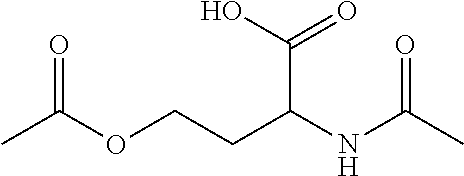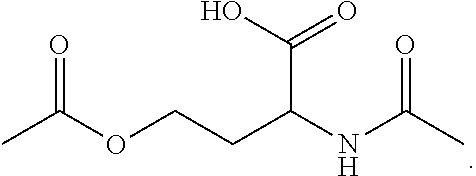N-acetyl homoserine
a technology of n-acetyl homoserine and n-acetyl homoserine, which is applied in the direction of lyases, carbon-carbon lyases, transferases, etc., can solve the problems of inefficient method and increase in methionine price relative to the increase in petroleum prices
- Summary
- Abstract
- Description
- Claims
- Application Information
AI Technical Summary
Benefits of technology
Problems solved by technology
Method used
Image
Examples
example 1
[0072]Formation of O-acetyl-N-acetamido-DL-homoserine from acetic acid with Escherichia coli For the biotransformation of acetate to O-acetyl-N-acetamido-DL-homoserine the genetically modified strain Escherichia coli W3110 ΔlysA lysCfbr thrAfbr ΔmetA pCDF{Ptac}[thrA_fbrEc]{Placuv5}[metX_Cg] was used. This strain harbours the following characteristics:[0073]i. Deletion of the E. coli W3110 lysA gene (SEQ ID NO: 8), encoding diaminopimelate decarboxylase[0074]ii. Deletion of the E. coli W3110 metA gene (SEQ ID NO: 10), encoding homoserine O-transsuccinylase[0075]iii. Expression of an allele of E. coli W3110 lysC gene (SEQ ID NO: 6), encoding a feedback-resistant variant of aspartokinase 3[0076]iv. Expression of an allele of E. coli W3110 thrA gene (SEQ ID NO: 5), encoding a feedback-resistant variant of bifunctional aspartokinase 1 / homoserine dehydrogenase 1[0077]v. Expression of the C. glutamicum ATCC 13032 metXgene (SEQ ID NO: 2), encoding homoserine O-acetyl transferase.
[0078]These...
example 2
[0099]Formation of O-Acetyl-N-Acetamido-DL-Homoserine from Acetic Acid with Corynebacterium glutamicum
[0100]For the biotransformation of acetate to O-acetyl-N-acetamido-DL-homoserine the genetically modified strain Corynebacterium glutamicum MH20-22B hom_fbr pECXC99E-{Ptrc}[metX_Cg] was used. The strain C. glutamicum MH20-22B is a chemical mutant which is described by Schrumpf et al. (Appl Microbiol Biotechnol (1992) 37:566-571) and expresses a feedback-resistant aspartate kinase. The strain was modified by Sahm et al. (Ann N Y Acad Sci. 1996 May 15; 782:25-39) to strain C. glutamicum MH20-22B hom_fbr, which expresses additionally a feedback-resistant homoserine dehydrogenase. Additionally, this strain was transformed with the plasmid pECXC99E-{Ptrc}[metX_Cg] (SEQ ID NO. 49), which encodes for a homoserine O-acetyltransferase (MetX) from Corynebacterium glutamicum ATCC13032.
[0101]For construction of the C. glutamicum expression vector for metX, the gene was amplified by PCR from ge...
example 3
[0109]No Formation of O-Acetyl-N-Acetamido-DL-Homoserine from Acetic Acid with Corynebacterium glutamicum
[0110]For the biotransformation of acetate to L-homoserine the genetically modified strain Corynebacterium glutamicum MH20-22B hom_fbr was used. The strain C. glutamicum MH20-22B is a chemical mutant which is described by Schrumpf et al. (Appl Microbiol Biotechnol (1992) 37:566-571) and expresses a feedback-resistant aspartate kinase. The strain was modified by Sahm et al. (Ann N Y Acad Sci. 1996 May 15; 782:25-39) to strain C. glutamicum MH20-22B hom_fbr, which expresses additionally a feedback-resistant homoserine dehydrogenase.
[0111]Corynebacterium glutamicum MH20-22B hom_fbr was cultivated on Corynebacterium agar plates (pH 7.3, 10 g / L caseine peptone tryptical digest, 5 g / L yeast extract, 5 g / L glucose, 5 g / L NaCl, 15 g / L agar) for 72 h at 30° C.
[0112]For the preculture 2×50 ml of CGS1 medium (pH 7.00, 10 g / L peptone, 5 g / L beef extract, 2.5 g / L NaCl, with additional 17.95 ...
PUM
| Property | Measurement | Unit |
|---|---|---|
| concentration | aaaaa | aaaaa |
| concentration | aaaaa | aaaaa |
| concentration | aaaaa | aaaaa |
Abstract
Description
Claims
Application Information
 Login to View More
Login to View More - R&D
- Intellectual Property
- Life Sciences
- Materials
- Tech Scout
- Unparalleled Data Quality
- Higher Quality Content
- 60% Fewer Hallucinations
Browse by: Latest US Patents, China's latest patents, Technical Efficacy Thesaurus, Application Domain, Technology Topic, Popular Technical Reports.
© 2025 PatSnap. All rights reserved.Legal|Privacy policy|Modern Slavery Act Transparency Statement|Sitemap|About US| Contact US: help@patsnap.com



